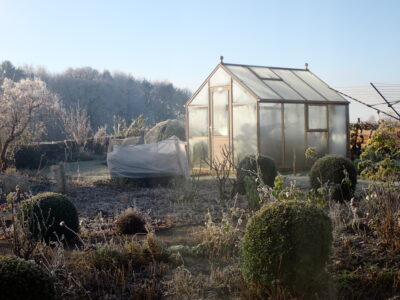
We’re in the bleak midwinter in the village of Cold Aston, high in the Cotswolds. And yet, there’s solace in the garden despite the bitter easterly wind and the threat of snow lingering in the pink-tinged clouds. We do snow well in Cold Aston, it falls thick and deep. However, I already have one witch hazel fully out, with soft-range flowers, and it’s been out since the 23rd December. I can be precise, because I walk round my modest garden every day without fail. The really interesting stuff right now is at the lower end of the garden, by the little stream. That’s where my woodland garden is. I also have a pink daphne in full flow.
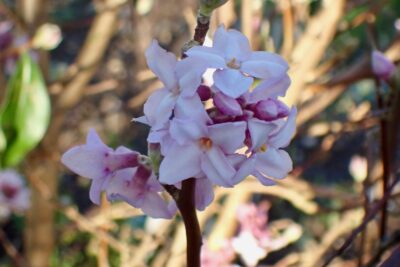

The soft-orange witch hazel is a named form of Hamamelis x intermedia, although I can’t recall which one! However, the most important part of this plant’s name is the small x in the middle, for it denotes a hybrid. Hybrids have extra vigour and they make better garden plants. They outperform their parents in size and growth rate, a process known as heterosis. Some hybrids are deliberately bred and good examples are F1 vegetables. Others appear on their own, having been pollinated.
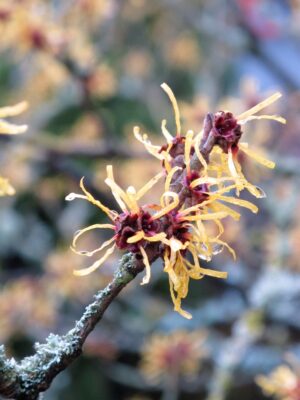
In the case of the hybrid witch hazel, intermedia tells us that this it’s a hybrid between two different species of hamamelis. These hybrids produce showier flowers in January, mostly, and the spidery flowers are not affected by the weather. That’s why I’ve crammed fourteen of them, far too many, in my woodland patch. Well. That’s my excuse! Witch hazel flowers are able to shrug off heavy rain, frost and snow and still keep their marmalade tentacles colourful. The spidery petals allow cold to escape, so they never brown.
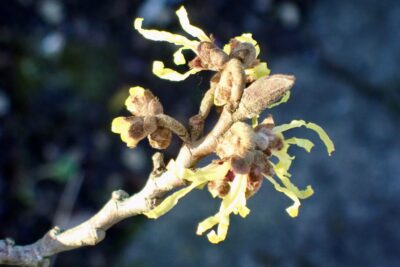
Witch hazels evolved, as most plants did, in the days when the earth consisted of one giant land mass. Continental drift occurred and produced, would you believe it, continents. Some witch hazels found themselves in Asia and others in North America. The continental drift theory, divided geographers. Indeed my own geography teacher, the lovely Mr Humphries, was slightly unsure of it all. A good botanist could have confirmed the theory for certain, because there were so many plant overlaps between the continents.
A lot of plants have footholds in Asia and the Americas including magnolias, hydrangeas, wisterias, mahonias and viburnums. To generalise the Asian ones outshine their American counterparts, because Asia suffered less glaciation. To get back to witch hazels, they evolved on two continents. When plant collectors began to bring Asian witch hazels into the Europe and North America, at the beginning of the 20th century, the Asian and American species were reunited. They produced hybrids off their own bat.
Perhaps the best hybrid hamamelis of all is H. x intermedia ‘Pallida’. It was found on Battlestone Hill in the RHS Wisley garden in Surrey in the 1950s. It has large pale-yellow flowers and these are freesia-scented. ‘Arnold’s Promise’, a yellow that’s always the last to flower, came from the Arnold Arboretum in Boston, Massachusetts in 1928. The flowers are rather small, though. Witch hazels produce seeds held in nut-like cases. I remove these to promote more flower, a fiddly job.
Robert and Jelena de Belder, who owned Kalmthout Arboretum in Belgium, deliberately bred witch hazels and named them after family members or arboretum staff. They planted their first one, ‘Ruby Glow’, in 1930 and set up a breeding programme because they were so impressed by the red flowers. ‘Jelena’, a coppery brown, was named in 1935. ‘Robert’, a coppery-yellow, and ‘Harry’, a large-flowered pale-orange, followed. ‘Diane’ (1969) was a red seedling from ‘Ruby Glow’ and many think it the best red of all. Reds tend to have smaller flowers and little scent.
If I had to choose one though, it would be ‘Barmstedt Gold’, because the golden-yellow flowers are held in bright-red calices. These intermedia hybrids do not need acid soil, but they do need deep soil. They also need summer rain, just like I need Marmite! In dry summers, they slant their foliage straight down. That’s a plea for water, because they’re trying to avoid transpiration. Gently tipping a can over them twice a week, until it rains, will give you more buds and bigger flowers next winter.
A lot of hybrid plants appear on their own. Some of them involve two closely related species and this produces a pollen incompatibility that leads to sterility. The flowers still attract pollinators, but they cannot be fertilised so they do not set seeds. This is a bonus, because the plant carries on flowering for many weeks, in a vain attempt. Some of our best hardy geraniums are sterile hybrids and they carry on flowering forever. ‘Rozanne’, voted the Plant of the Centenary at the 110th Chelsea Flower Show in 2016, is a prime example. It’s sold all over the world.
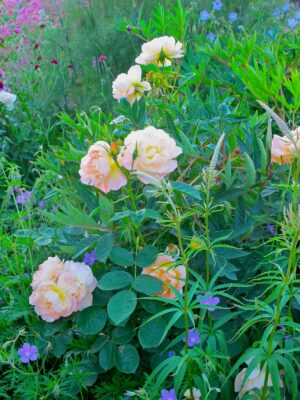
‘Rozanne’, a large sprawling plant, can cover a meter of ground. It tends to smother things, but it flowers on through wet summers and droughts alike, undeterred. It was discovered in 1990 in the Somerset garden of Donald and Rozanne Waterer and it’s a hybrid between Geranium himalayense and Geranium wallichianum. Blooms of Bressingham promoted this plant, because it needed to be micro-propagated to produce enough numbers for the launch at the Chelsea Flower Show of 2000. It still took a full ten years to turn that one chance discovery into thousands of plants. Commercial horticulturalists have to make money, but it’s not what drives them. It’s sheer joy and enthusiasm.
Alan Bremner set about deliberately breeding sterile geraniums on the Island of Orkney and they are worth a place in any garden. ‘Patricia’ had dark-eyed bright-magenta flowers from July onwards. It’s a 1992 hybrid between G.endressii and G.psilostemon, named after a lady called Patricia Doughty. It’s a large hardy geranium and it tolerates some shade. ‘Dragonheart’ (2006) is also magenta, although slightly more subdued in colour. Alan also raised compact pink geraniums named after Hardy Plant ladies. ‘Dylis’ is named or Dilys Davis and ‘Joy’, for Joy Jones, and both need reasonable drainage. The pale-pink ‘Dreamland’ (1996) flowers prolifically from May until September. It also needs good drainage and it has struggled to come through winters for me.
There are plenty of other sterile plants and many have become garden classics. The wallflower, ‘Bowles’s Early Mauve’, flowers on for months although E.A. Bowles said that it didn’t come from his Myddelton House garden in Enfield, Middlesex. Polemonium ‘Lambrook Mauve’, a Jacob’s ladder given to Margery Fish. is another and it’s a blessing not to get any polemonium seedlings from this one. Astrantia ‘Roma’ won’t self-seed and, just like ‘Buckland’ it will flower over many weeks. Aster x frikartii ‘Mönch’ is a drought-tolerant aster guaranteed to start in July and it will still be going strong in September.
Double flowers also endure because the business-end of the flowers, the anthers, style and stamens, have been replaced by extra petals. This is why so many dahlias, roses and peonies have full flowers: they last far longer. Single dahlias, such as ‘Twyning’s After Eight’ need regular deadheading, at least three times a week, otherwise they produce seeds. After that it will be ‘job done’ and your plant will call a halt to flowering. A double white dahlia on the other hand, like ‘My Love’, can be tackled once a week. The downside to doubles is that they offer nothing to the pollinator. Gardeners need to grow singles and semi-doubles as well as fully double plants.
This is the best time to order dahlia tubers and you’ll find an excellent range in the Rose Cottage Plants website. www.rosecottageplants.co.uk
The website’s colour-themed, which makes it easier to pick your desirables. Anne Barnard has a great eye and she travels to Holland to select the best.











